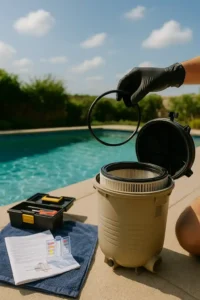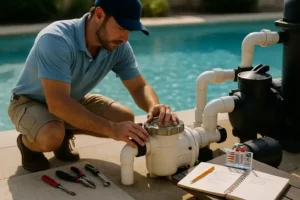If you own a pool in the Lone Star State, you’ve probably faced a few surprises—maybe the pump started gurgling like a coffee pot or the filter quit mid-cycle during a 100-degree afternoon. That’s when the phrase pool equipment repair in Texas becomes a whole lot more than just a search term—it’s a summer survival skill.
This article is your go-to guide for identifying early signs of trouble, making quick fixes when possible, and recognizing when it’s time to wave the white flag and call a professional. Because let’s be honest—Texas heat doesn’t wait.
 Why timely pool equipment repair in Texas is a must
Why timely pool equipment repair in Texas is a must
There’s a local saying: “Don’t tamper with Texas pools.” Alright, perhaps not in an official sense, but it ought to be. The severe climate and continuous operation cause your equipment—particularly the pump and filter—to work extra hard.
The important term here is prevention. A small problem, such as a minor leak or a loud motor, can rapidly escalate into a complete system breakdown if overlooked. Believe me, no one wishes to change a pool pump during a scorching heatwave
Pool equipment repair in Texas isn’t just about maintenance. It’s about peace of mind.
Early warning signs your equipment is failing
You don’t have to be a technician to spot trouble early. Here’s what you should keep an eye (and ear) out for:
Strange noises
Grinding, screeching, or rattling sounds often mean motor or impeller issues.
Weak water flow
If your jets suddenly feel more like a lazy river, your pump might be clogged or failing.
Cloudy or dirty water
A sign your filter isn’t doing its job properly.
Air bubbles in the return jets
Usually caused by air leaks in the suction line.
Leaking water
Around the pump, filter, or pipes? Don’t wait. Moisture can signal cracks or worn seals.
These little signs are your pool whispering, “Help me out.”
A Step-by-Step guide to DIY pool equipment repairs
For pool equipment repair in Texas, quick action can reduce both stress and expenses. Here’s a guide on diagnosing and resolving typical issues.
1. Clogged Pump Basket or Skimmer
- Shut off power.
- Open and clean out basket.
- Replace lid tightly.
2. Dirty or Full Filter
- For sand or DE filters, backwash.
- For cartridge filters, remove and rinse with a hose.
- Replace filters if torn or discolored.
3. Pump Not Priming
- Check for leaks in suction line.
- Fill pump housing with water.
- Restart and watch for steady flow.
4. Timer Malfunctions
- Reset timer.
- Replace battery if digital.
- Ensure the unit is getting power.
5. Motor Overheating
- Ensure the pump is shaded and ventilated.
- Clear debris around the housing.
Even if you’re not a DIY kind of person, these quick steps can help you stabilize the situation until a tech can arrive.
When to call a pro (and not feel bad about it)
Sometimes, the best repair is knowing when to step back. Call a professional when:
- There’s electrical failure or wiring issues.
- Your pump won’t start despite troubleshooting.
- You see frequent tripping of breakers.
- Cracks appear in filter tanks or pipes.
- You’ve tried the fix, and the problem returns.
Trust your gut. If it feels beyond your skill level, it probably is—and that’s perfectly okay.
 Smart tips for preventing equipment failure
Smart tips for preventing equipment failure
- Routine Inspections: Give your equipment a once-over every weekend.
- Use a Pump Cover: Shade your pump from the brutal sun.
- Flush the System: Clean pipes and jets monthly.
- Install a Surge Protector: Protect electronic parts during lightning storms.
- Schedule Professional Maintenance: Even once a season can make a difference.
Just like your car needs oil changes, your pool needs love too. Especially in Texas.
The emotional cost of pool problems (A real story)
Last summer, my cousin Rick thought he could ignore the little whining noise from his pump. “Probably a frog,” he joked. Two weeks later? Total motor burnout. His Fourth of July bash? Cancelled. And let me tell you, explaining to twenty barbecue-ready kids that they can’t swim because the pool is out of commission? That’s a heartbreak no parent wants.
It’s why pool equipment repair in Texas should never wait.
One simple list that can save you hundreds
Before summer kicks off, run through this quick list:
- Check for moisture or leaks.
- Listen for strange sounds.
- Make sure timers run as programmed.
- Inspect pool pump, filter, and connections.
- Confirm flow rate is strong.
Tools that make quick repairs easier
Having a few tools on hand can make a world of difference:
- Water-resistant screwdriver set
- Plumber’s tape
- Spare o-rings
- Silicone-based lubricant
- Multimeter (for electric diagnosis)
Plus, keep a spare filter cartridge and gasket kit handy. You never know.
Keeping your pool in top shape doesn’t necessitate being a tech specialist. It simply needs concentration, a bit of time, and the willingness to act before circumstances deteriorate.
In Texas, pool equipment repair serves as your safety cushion—a means to maintain refreshing water circulation and reduce stress, even during those scorching 105-degree days.
So grab a flashlight, listen closely to your equipment, and trust your instincts. A little care today means a better swim tomorrow.
Oh, and if you’re serious about keeping your pool pristine, don’t miss our other article on Weekly Summer Maintenance in Texas: A Step-by-Step Guide. It’s the perfect next read.
Frequently Asked Questions
1. How do I know if my pool pump needs replacing?
If your pump makes loud noises, trips your breaker, or loses power entirely—even after cleaning—it may be time to replace it.
2. Can I fix a leaking filter myself?
Sometimes, yes. If it’s a loose clamp or gasket, you can tighten or replace the part. But if the tank is cracked, call a pro.
3. Why is my water flow weak?
Check for clogs, air leaks, or worn impellers. Your pool pump might need servicing.
4. Is it safe to run a noisy pump?
Short answer: no. It could damage the motor further or signal overheating.
5. What’s the most common reason for filter failure?
Dirty cartridges or worn-out sand are the usual suspects. Regular filter maintenance is key.
